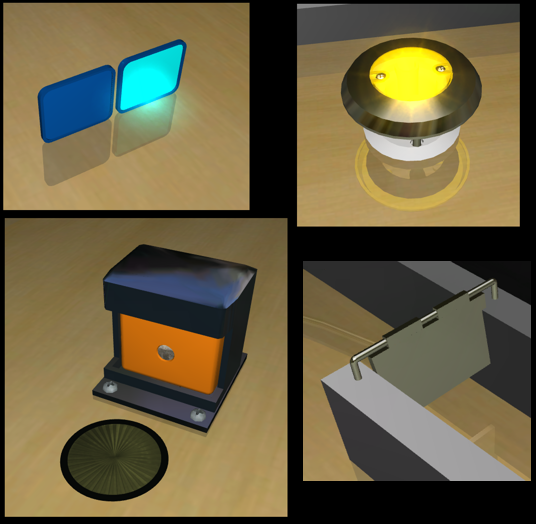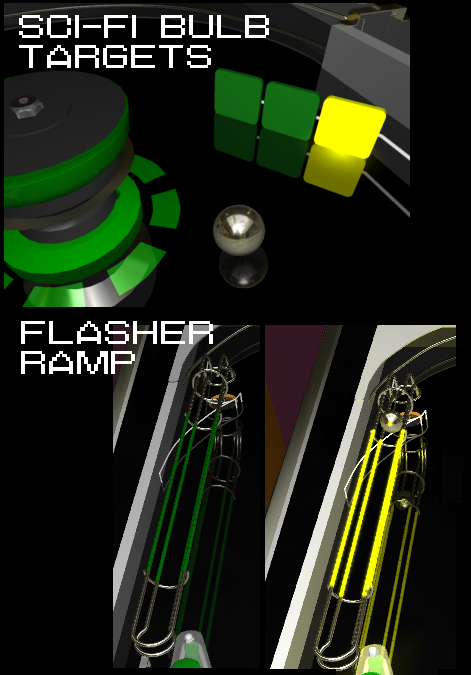Way back in 2011, I posted some models in GoPinball, on a topic called Wecoc's Tons of AddOns. That topic is long gone, but I got most of those models back into a single table, and also revamped a few, so they work better. Some even have BAM features now! 
Models included:
- 4 "target lights", or targets that lit when you hit them.
- 3 custom bumper caps
- 1 metal ornament for bumper caps
- 1 metal ornament as "target housing" box
- 3 custom diverters
- 2 basic flasher models
- 1 custom wire gate
- 1 "plunger nut" used to hold the ball on the plunger (includes custom orn-hole)
- 1 small screw
- 2 plastic pegs (Gottlieb)
- 1 custom semicircular trigger
- 3 snap targets
- 3 spin posts [requires BAM]
- 1 cut wire trigger [requires BAM]
The table also provides all the code examples to make the complex ones work properly.

Screenshot used on the old topic. The metal gate is not included.

Screenshot used on the old topic. The ramp is not included since it was made with a lot of flashers and it caused lag. Other approaches may be possible nowadays by using BAM.
Peace out, I hope you find these models cool as beans! (this was still said in 2011, right?)
Models included:
- 4 "target lights", or targets that lit when you hit them.
- 3 custom bumper caps
- 1 metal ornament for bumper caps
- 1 metal ornament as "target housing" box
- 3 custom diverters
- 2 basic flasher models
- 1 custom wire gate
- 1 "plunger nut" used to hold the ball on the plunger (includes custom orn-hole)
- 1 small screw
- 2 plastic pegs (Gottlieb)
- 1 custom semicircular trigger
- 3 snap targets
- 3 spin posts [requires BAM]
- 1 cut wire trigger [requires BAM]
The table also provides all the code examples to make the complex ones work properly.
Target lights
It's a bulb in the shape of a target, with a leap target hidden inside. I also used this trick with default targets way back in 2011 on my table Caelestis. You can also find more here.
Snap Targets
Snap Targets are very similar to what in Future Pinball is called Swing Targets, but made using a Toy, a Timer and hidden collision walls. With this, you can control the exact position of the target, move it to a desired angle, change its speed, or even hide it like a drop target. This type of targets were used in some pinballs of the 60s, like Mayfair.
Spin Posts
A two-winged diverter that constantly spins, available in three sizes. The original was made using a modified spinning disk, but the new version uses a trigger and a MiniPlayfield (BAM). This allows control on its angle and speed, as well as a sphere-map textures. The same models could be easily modified back to the spinning disk versions if preferred. In the other hand, the same code could be used for other spinning objects like fidget spinners.
Cut Wire Trigger
The outer-lane wire triggers in some classic pinballs are cut, so the ball can't get up if it recedes from the flipper area. For example, you can see it in the pinball Aztec. This one-directional wire is recreated with a very simple BAM code.
It's a bulb in the shape of a target, with a leap target hidden inside. I also used this trick with default targets way back in 2011 on my table Caelestis. You can also find more here.
Snap Targets
Snap Targets are very similar to what in Future Pinball is called Swing Targets, but made using a Toy, a Timer and hidden collision walls. With this, you can control the exact position of the target, move it to a desired angle, change its speed, or even hide it like a drop target. This type of targets were used in some pinballs of the 60s, like Mayfair.
Spin Posts
A two-winged diverter that constantly spins, available in three sizes. The original was made using a modified spinning disk, but the new version uses a trigger and a MiniPlayfield (BAM). This allows control on its angle and speed, as well as a sphere-map textures. The same models could be easily modified back to the spinning disk versions if preferred. In the other hand, the same code could be used for other spinning objects like fidget spinners.
Cut Wire Trigger
The outer-lane wire triggers in some classic pinballs are cut, so the ball can't get up if it recedes from the flipper area. For example, you can see it in the pinball Aztec. This one-directional wire is recreated with a very simple BAM code.

Screenshot used on the old topic. The metal gate is not included.

Screenshot used on the old topic. The ramp is not included since it was made with a lot of flashers and it caused lag. Other approaches may be possible nowadays by using BAM.
Peace out, I hope you find these models cool as beans! (this was still said in 2011, right?)
